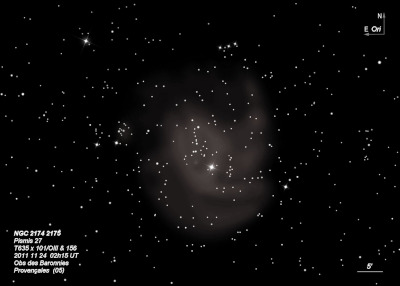Monkey Head Nebula
Monkey Head Nebula

Édouard Stephan discovered NGC 2174 = St IX-7 on 6 Feb 1877. His description doesn't refer to the entire nebula but rather a small patch of nebulosity (without the accents): "excessive., excess. faible (a peine observable); a l'interieur d'un triangle forme par trois petites etoiles."
He gives a 1878 position of 06 02 07.47 +20 40 54.4 which precesses to 06 09 24.0 +20 39 53 (2000), and falls on the northwest side of the nebula. This probably needs a small correction in declination based on his reference star, but is still accurate enough to clearly identify a small brighter patch of nebulosity. His three stars are mag 13-14 and the knot of nebulosity is quite prominent on the DSS just following the middle of these three stars. This star has a position of 06 09 21.9 +20 39 30 (2000) and Stephan's knot appears only 30-40" in diameter.
300/350mm - 13.1" (1/18/85): very bright with filter, very large, surrounds a mag 8 star, sky very dark off west side. West of the star the nebula is mottled and streaky with a bright region near the north edge.
400/500mm - 17.5" (1/16/02): at 64x and OIII filter, this is a beautiful, detailed nebulosity surrounding a mag 8 star (SAO 78049), extending at least 20' diameter. The OIII filter gives a dramatic contrast gain. With averted vision and careful viewing, the outer borders extend to ~25'. Structure includes interior streaky dark lanes visible to the west of the star. The rim is slightly brighter or has a higher contrast on the western edge but slightly more nebulosity is visible on the following side of the star.
Without a filter at 64x, I was surprised to immediately notice a moderately bright 3' round glow, situated ~11' NNW of SAO 78049 near the NW edge of the main glow. Interestingly, this patch of nebulosity is more prominent than the main body without a filter and is probably the section of the HII complex visually discovered by Stephan! It seemed quite strange that this patch had such a different filter response and dimmed significantly with the OIII (mainly reflection component?). A curving arc of stars is situated along the north side of the glow. The entire nebula is situated among a scattered group of stars, which is often mistaken for NGC 2175. Located 1.4 degrees ENE of Chi(2) Orionis.
17.5" (2/28/87): very large, irregular nebulosity surrounding mag 8.0 SAO 78049. Dark lanes are evident west of the star, appears very streaky. A bright small unresolved knot is 3.2' ENE of the bright star using an OIII filter [this is NGC 2175].
Notes by Steve Gottlieb